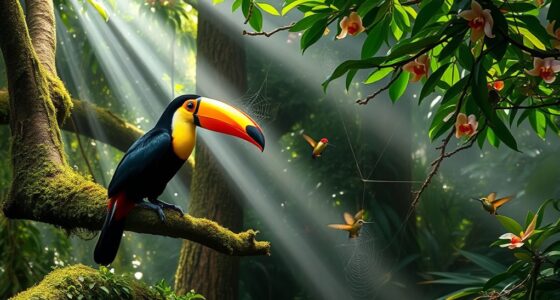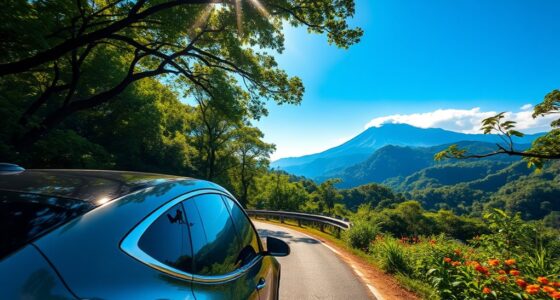When visiting Corcovado National Park, respect wildlife by keeping a safe distance and using a telephoto lens for your photos. Keep your voice down and avoid sudden movements to minimize stress for the animals. Always follow park rules, never feed or touch wildlife, and stick to designated trails to preserve the environment. By adopting these practices, you help protect the park for future visitors. There’s plenty more to learn about ensuring a respectful wildlife experience.
Key Takeaways
- Maintain a safe distance from wildlife to prevent stress and ensure their comfort during your visit to Corcovado National Park.
- Use telephoto lenses for unobtrusive photography, allowing you to capture images without disturbing animals.
- Stay quiet and minimize sudden movements to enhance your observation experience and avoid startling wildlife.
- Follow park rules and guides’ instructions to ensure your safety and the preservation of the park’s ecosystems.
- Always stay on designated trails to minimize environmental impact and protect fragile habitats from erosion.

When you step into the breathtaking wilderness of Corcovado National Park, it’s easy to get lost in the beauty of the diverse wildlife. The sounds of howler monkeys, the sight of scarlet macaws soaring overhead, and the chance to spot elusive jaguars create an unforgettable experience. However, while you’re soaking in these moments, it’s vital to remember wildlife viewing etiquette to guarantee both visitor safety and the well-being of the animals.
First and foremost, practice ethical photography. You might feel tempted to get up close for that perfect shot, but it’s essential to respect the animals’ space. Maintaining a safe distance not only protects you but also prevents stress on the wildlife. Animals in Corcovado, like the endangered Baird’s tapir or the playful capuchin monkeys, can react unpredictably when they feel threatened. Using a telephoto lens can help you capture stunning images without intruding on their natural behavior. Always prioritize their comfort over your desire for a photograph.
Practice ethical photography by respecting wildlife space and using a telephoto lens for stunning, unobtrusive shots.
As you venture through the park, keep your voice down and avoid sudden movements that could startle the creatures you’re hoping to observe. Remember, you’re a guest in their home. Staying quiet not only enhances your experience but also allows you to notice subtle behaviors you might otherwise miss. If you’re in a group, encourage others to follow suit for a more peaceful atmosphere.
Visitor safety is another critical aspect of wildlife viewing. Corcovado is home to a variety of species, some of which can be dangerous if approached. Always heed park guidelines and follow your guide’s instructions. They’re trained to help you navigate the park safely while enriching your experience with their knowledge. If you encounter an animal, observe from a distance, and never attempt to feed or touch them. Not only is this unsafe, but it can also disrupt their natural feeding habits.
Finally, think about your impact on the environment. Stay on designated trails to minimize erosion and avoid trampling fragile ecosystems. Carry out what you bring in, including trash, to keep the park pristine for future visitors and wildlife alike. By following these etiquette guidelines, you contribute positively to Corcovado National Park, guaranteeing that its beauty endures for generations to come. Additionally, understanding color accuracy can enhance your wildlife photography, making your images more vibrant and true to life. So, as you explore, keep these principles in mind, and you’ll enhance both your experience and the well-being of this incredible ecosystem.
Frequently Asked Questions
Are There Specific Seasons for Optimal Wildlife Viewing in Corcovado?
Yes, there are specific seasons for the ideal wildlife viewing in Corcovado. You’ll find peak wildlife periods occur during the dry season, from December to April. Many animals, including migratory birds, visit during this time, making it perfect for spotting diverse species. If you time your visit with the seasonal migration, you’ll enhance your chances of witnessing incredible wildlife interactions. Plan ahead, and enjoy the vibrant biodiversity that Corcovado has to offer!
Can I Bring My Pet While Visiting the Park?
You can’t bring your pet while visiting the park. It might seem tempting, but the pet restrictions are strict for a reason. Imagine stumbling upon a rare animal encounter, only to have your furry friend disrupt the moment! The park’s diverse wildlife needs to feel safe, and pets can disturb their natural behavior. So, leave your pet at home and immerse yourself in the breathtaking, unspoiled beauty of the park instead.
Is Camping Allowed Within Corcovado National Park?
Yes, you can camp in Corcovado National Park, but there’re camping restrictions you need to adhere to. You must use designated camping areas to safeguard the park’s preservation and your safety. These spots are equipped to handle visitors while minimizing environmental impact. Be sure to check for any required permits and guidelines before your trip. Enjoy the stunning nature, but remember to respect the rules for a safe camping experience!
What Should I Wear for Wildlife Viewing in the Park?
For wildlife viewing in the park, wear weather-appropriate clothing that suits the conditions—think lightweight, breathable layers for warmth and moisture management. Don’t forget a hat and sunscreen for sun protection. Appropriate footwear is essential, so choose sturdy hiking boots with good traction to navigate uneven terrain. If it’s rainy, waterproof gear will keep you comfortable. Remember, staying dry and protected helps you focus on the incredible wildlife around you!
Are Guided Tours Available for Wildlife Viewing Experiences?
Yes, there are plenty of guided tour options available for wildlife viewing experiences. You’ll find knowledgeable wildlife expert guides who can enhance your adventure by sharing insights about the local flora and fauna. These tours often cover the best spots for sightings and guarantee you won’t miss hidden gems. Plus, having a guide means you’ll get tips on safety and etiquette, making your experience even more enjoyable and enriching.
Conclusion
By following these wildlife viewing etiquette tips in Corcovado National Park, you’re not just protecting the animals; you’re creating an unforgettable experience that’ll feel like stepping into a real-life nature documentary. Remember, your respect for the environment and its inhabitants can make all the difference. So, keep your distance, stay quiet, and let the magic of the wild unfold around you. After all, every moment spent in this paradise is a treasure waiting to be discovered!










